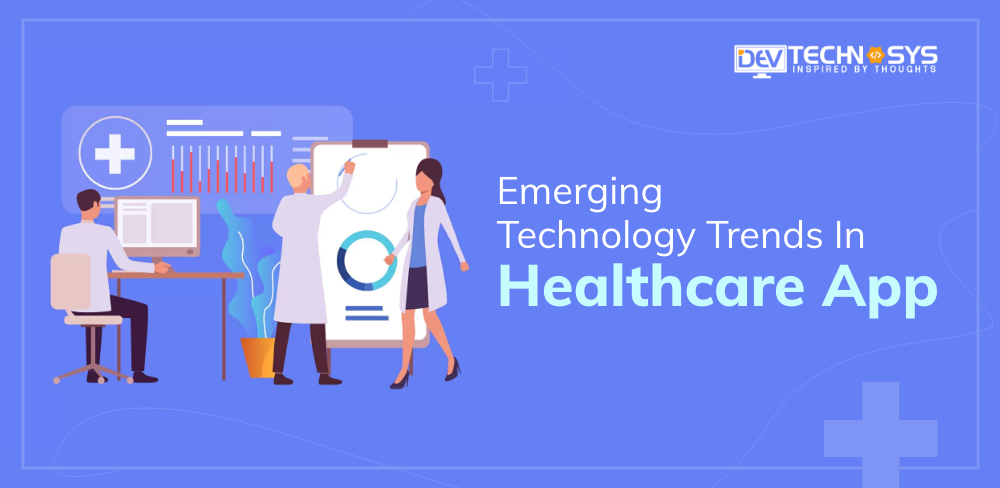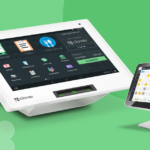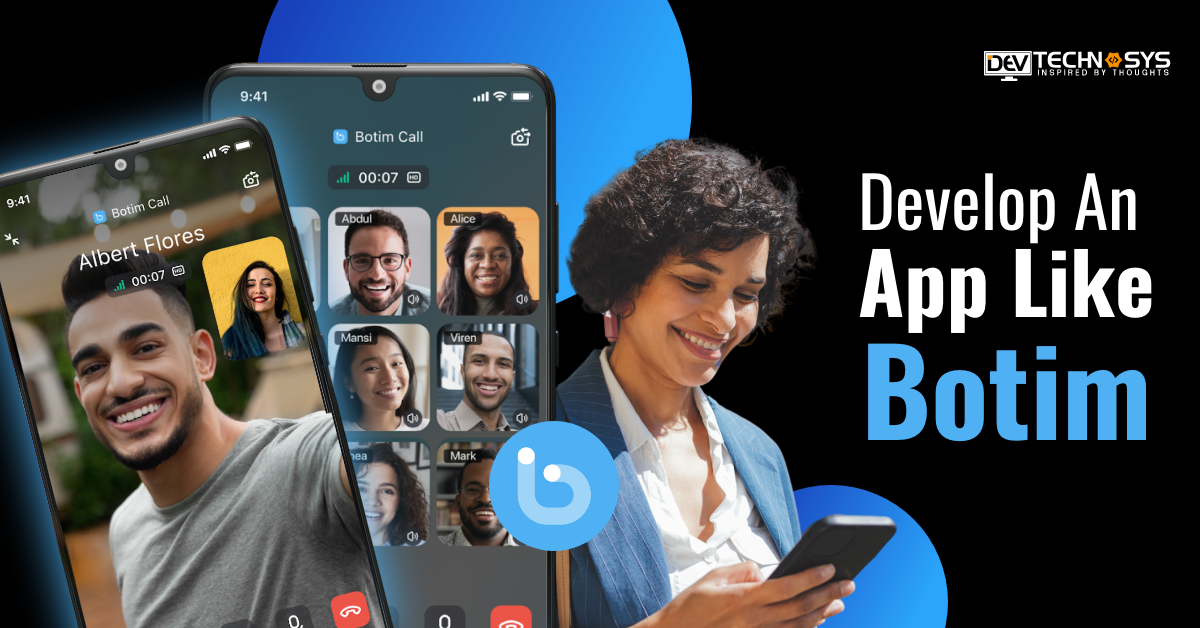Healthcare is always changing. The latest technology trends in healthcare are changing how we access patient care. New developments in healthcare software development are gaining center stage. Gone are the days when patients had to be seen in person, and medical records were kept on paper.
The healthcare industry has seen a significant increase in demand for software solutions since the introduction of the Electronic Health Record (EHR). Digital health solutions have come about as a result. According to Grand View Research, the worldwide healthcare IT industry is anticipated to reach USD 142.7 billion by 2022.
This will increase at a CAGR of 17.9% over the forecast period. It’s time for your healthcare company to consider mobile application development companies.
Partnering with custom software development services that develop healthcare apps will ensure you stay informed about what is happening in the industry.
So, what precisely are the most popular technical developments in healthcare today that everyone is raving about?
The healthcare industry is about to undergo a digital revolution. It includes Artificial Intelligence & Machine Learning, Telemedicine, Blockchain, Wearables & IoT Devices, and Telemedicine.
This blog will explore the top technology trends in healthcare. It will also discuss challenges and benefits. Be ready to enter the digital revolution and healthcare innovation of the future.
Table of Contents
What is The Importance of Understanding Healthcare Trends?
Healthcare is an ever-changing and rapidly changing field. It doesn’t matter if you are a professional; it’s important to keep up with the technology trends in healthcare and stay informed about the latest SaaS software development.
Many factors are involved – the changes in lifestyles, longer lifespans, the evolving healthcare system, and digitization. This has led to a rapidly changing healthcare landscape.
Organizations can analyze and identify gaps and inconsistencies and then solve them by learning about the upcoming technology trends in healthcare. Healthcare technology trends could revolutionize the industry.
Top Technology Trends in Healthcare industry
Here are major technology trends in the healthcare industry that are transforming the healthcare industry.
So let’s have a look.
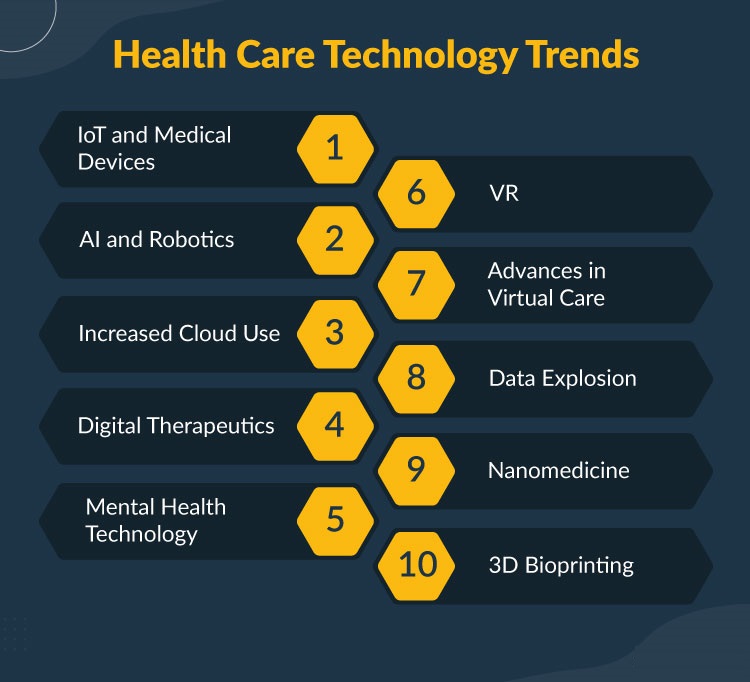
1. Patient Engagement can be Increased by Improving The Patient Experience
Patients are becoming more proactive and savvy about their own self-care as mobile technology advances. Patients and providers now work together to transform the healthcare industry.
They take a proactive approach to care instead of depending on active ones. Clinical results and quality of life can both improve as a result of patient participation and self-advocacy.
Healthcare leaders must ensure that every patient journey is personal and free from obstacles so that patients can continue to be involved in their care. Various companies are now including chatbots in healthcare which helps in the performance of apps.
Improving the patient experience is the number one priority of health organizations in order to increase patient engagement. Many businesses have found it easy to reduce friction points and simplify processes, particularly in the retail sector. Healthcare providers must consider this, and realize that customers can easily defect to other companies if they have not had a positive experience.
Healthcare leaders must consider these factors to improve patient satisfaction:
- Access to patient data is easy
- Digital experience for the patient
- Administrative efficiency
- Human connection: Building in
- Recognizing the importance and value of work culture
2. Big Data in Healthcare
The healthcare industry has huge opportunities with big data. Big data can be accessed from multiple sources, including patients’ medical records, hospital records, and the effects of medical examinations.
Biomedical research can help you create an important portion of big data applicable to public health care. To analyze and organize this data for healthcare, you need high-level management.
Electronic Health Records (EHRs), which allow for faster data rescue and promote key indicators of healthcare quality to organizations, improve public health surveillance, and immediately report disease outbreaks.
According to research, global data will grow at a rate of 22.07% (CAGR of $34.27 billion) by 2023. The meaningful data analytics segment also states that data will generate $68.03 billion in 2024.
3. Internet of Medical Things
The internet-connected devices of today in every industry are specifically designed to increase efficiency and reduce costs. The Internet of Medical Things was created to provide computing power and wireless capabilities that enable an AI development company to take full advantage of IoMT technologies.
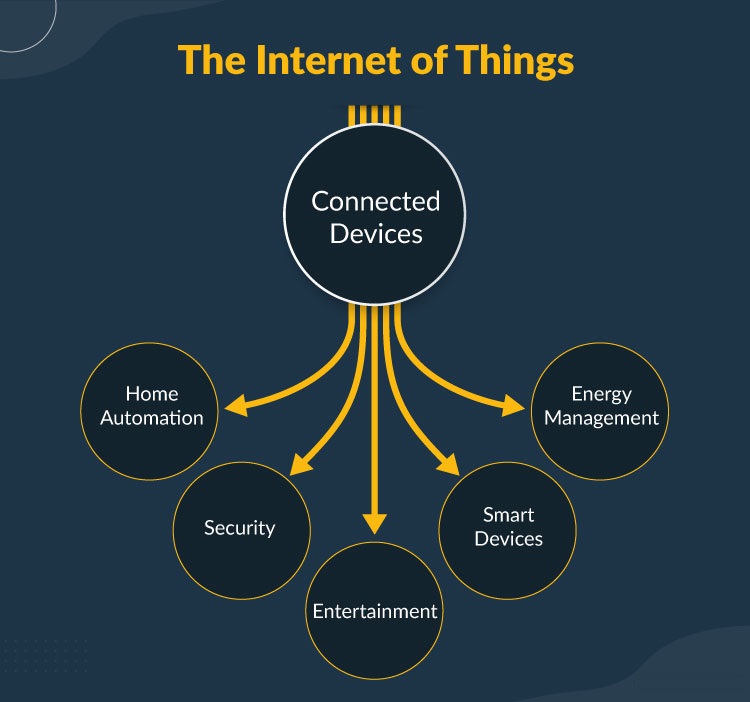
It is designed to improve healthcare outcomes. IoMT apps play an important role in monitoring and controlling chronic diseases for patients and clinics, and they are poised to be the future of healthcare.
The Internet of Medical Things (IoMT), in short, is an infrastructure of services that provides both rural and urban healthcare. IoMT is the answer for patients who cannot access their healthcare provider.
4. The Potential of IoMT For Healthcare
Researchers from UCLA and Cedars-Sinai Medical Center have demonstrated that Fitbit activity trackers can be used to accurately evaluate patients suffering from ischemic heart disease.
They simultaneously record their heart rate and accelerometer data. It will help the health intelligence report that 88 percent of healthcare providers invest in remote patient monitoring solutions.
5. Artificial Intelligence in Healthcare
Artificial intelligence (AI), has the potential for the industry to change. It changes the way it is delivered and upgrades it with new technology trends in healthcare and aspects for 2023.
The European Union’s EIT Health conducted a combined study to examine how AI can be used to improve healthcare and patient experience.
Hospitals will invest more in medical equipment by 2023. Artificial Intelligence (AI), which is a form of artificial Intelligence, allows you to see more effectiveness in infection prevention and control (IP&C), programs that AI powers.
This allows you to monitor patients in real time, and artificial Intelligence will enable care providers to quickly identify infection risks and initiate clinical intervention.
Healthcare with AI can make a huge impact on the future of healthcare. It can drive population aging, change patient expectations, shift lifestyle choices, and invent new ways to improve healthcare.
Here are some examples:
- Enhance healthcare professionals’ daily lives, spend more time with patients, and increase staff morale and retention.
- AI may be used to accurately determine the hostility of certain cancers and their target treatments.
- Artificial Intelligence helps to encourage “virtual biopsy” and keeps radionics at the forefront of innovation.
- AI offers many advantages over traditional analytics, clinical decision-making strategies, and other methods of data analysis.
- Artificial Intelligence will be a key component of the next-generation radiology tools. It may even replace the need to obtain tissue samples in certain situations.
- It will facilitate speedier therapy.
6. Cloud Transformation
Healthcare organizations are mostly unable to grasp the essentials of long-term cloud methods. They are clueless as to what to do, how to proceed, what data to migrate, and when. Proper planning for cloud migration will optimize resources, reduce costs, and leverage tech stacks.
These are problems that have plagued cloud infrastructures for years. Many businesses plan to take help from healthcare CRM software solutions to develop healthcare software CRM integration.
7. Security
A recent IBM report found that healthcare data breaches cost an average of USD 10 million. Due to severe sanctions, medical organizations risk losing their patients’ trust and businesses.
Healthcare privacy and security will continue to be crucial for the industry after 2023, and protecting patient data will remain a top priority. Any healthcare device that processes patient data must adhere to strict security standards.
This is just a starting point. The cybersecurity teams go above and beyond the security requirements. Some companies use modern platforms that allow for compliance updates to be performed continuously, and they always upgrade them with advanced digital resilience testing.
8. IT Outsourcing
The key to your digital transformation journey is finding the right software provider. Many healthcare organizations have turned to remote software development centers to collaborate.
They can focus on their core competencies and still have the flexibility and scalability that an in-house team would not be able to offer. Eastern Europe is home to an impressive talent pool. Companies can pick top engineers and project managers, as well as top developers.
In addition, cutting-edge technology speeds up time to market, and different time zones increase business coverage. This is why the region’s popularity will only grow, especially among its EU members Bulgaria and Romania.
9. Wearables & IoT Devices
IoT and wearable devices are becoming major technology trends in healthcare. This is especially essential for healthcare software development. Wearables such as smartwatches and fitness trackers can collect and store data on sleep habits, heart rate, and physical activity.
Healthcare app developers can use this information to provide more personalized and efficient care.
IoT devices like smart home gadgets and connected medical devices can be used to enhance healthcare. They allow remote monitoring and management of chronic diseases. Smart home appliances can monitor and treat patients with diabetes and cardiovascular disease.
They provide early warning signs of exacerbations, enabling prompt intervention.
Wearables and IoT devices are the latest technology trend in healthcare in 2023 and beyond. Healthcare organizations may enhance patient outcomes, cut expenses, and promote innovation in their operations.
10. Telehealth Systems are Being Used More Frequently
Telehealth is not new. But it was brought to the forefront by Covid-19. Patients were less likely to visit their doctors in person, and there was a shortage of healthcare workers in all countries. Telehealth is now on many top-of-the-line technology trends in healthcare lists.
Patients with non-emergency medical conditions may be able to access their healthcare providers faster and cheaper than with traditional visits.
They can make remote, live-video appointments from their mobile phones or computers. Telehealth systems also allow patients to communicate directly with their providers and organizations regarding any concerns, from insurance questions to prescription changes.
Telehealth systems also allow you to integrate information from multiple patient visits and test results into electronic records. This makes it easier to check your patient’s medical history in one place.
Telehealth systems can also be linked to data from wearables to allow patients to stay involved and proactive in their care. This is particularly important for chronic conditions like high blood pressure and heart disease.
Telehealth systems are expanding rapidly and leadership teams must ensure that it is safe, reliable, and equitable access for all populations, especially rural areas, and individuals with disabilities.
Many healthcare organizations can benefit from a seamless user experience with telehealth systems. Telehealth is here to stay due to its ease of use and access to care.
11. Implants and 3D Bioprinting
There is still much to be done in smart implants and 3D Bioprinting before they can be used fully for creating personalized medical solutions for patients. These cutting-edge technologies will allow medical facilities to provide better care and outcomes in 2023.
Smart implants are small, computerized devices that are implanted into the body to monitor and possibly restore functional independence for patients who have paralysis or blindness. A team of scientists installed a tiny microelectrode array, about the size of a penny, into the visual cortex to enable people living with blindness to see letters and shapes.
3D Bioprinting is a 3D printing process that uses bio ink to create living tissue or organs. This opens up new possibilities for regenerative medicine. It makes it possible to print new bones, cartilage, or complete organs, such as hearts and livers.
These top digital technology trends in healthcare are expected to have an enormous impact on the US healthcare industry. They will continue to develop and become more common, and they will play an increasing role in improving patient care as well as advancing medical science.
Mobile Technology Trends in Healthcare: The Benefits
The benefits of automation in healthcare are many for patients, caregivers, and healthcare organizations. Here are some benefits of mobile technology trends in healthcare:
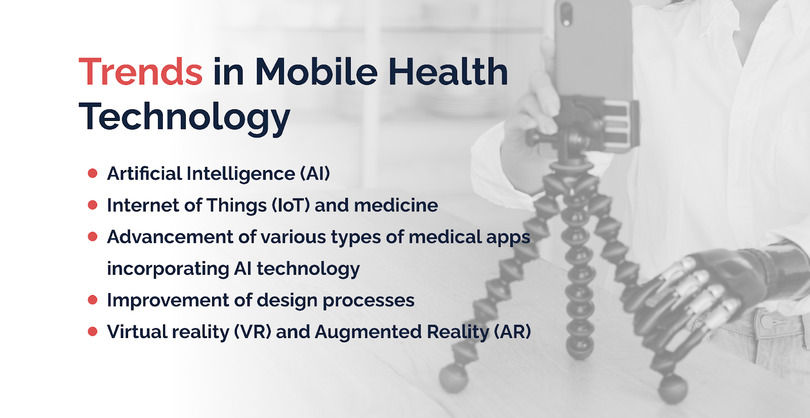
1. Reduction in The Risk of Errors
To make accurate diagnostic decisions, medical professionals must have an approach to a wide range of clinical resources. Doctors and nurses can now access their medical data, laboratory results, and other information within minutes using mobile health technology.
Doctors and nurses can use smartphones and apps to access drug reference guides, clinical rules, and other decision-support tools. Making informed medical decisions reduces the chance of errors and increases productivity. The patient can be proactive and get early warning of potential complications so they can plan their treatment accordingly.
2. Streamlining Clinical Processes
According to the study, the IoT healthcare market is expected to reach $188.2 million by 2025. This shows that healthcare professionals are investing in innovative apps and ideas to make the industry more efficient.
The IoT has also allowed for a better way to manage resources, and they can also monitor their massive stock levels and maintain them systematically.
3. A healthy lifestyle
Innovative healthcare technology and apps are vital for a better lifestyle. The latest digital accessories, such as smartwatches and fitness trackers, are designed to help people eat well, stay fit, and have a positive impact on their sleep patterns.
These apps allow users to track their diet, weight, food intake, and pulse. They can also monitor calorie intake and other personal information. To get better support and advice, users who use these technology trends in healthcare can share their data with their fitness coaches or other companions.
What are The Challenges Faced by Healthcare Technology Innovation?
Healthcare intelligence tools allow you to organize and gather medical information. This includes doctor visits, diagnosis, billing and payments, prescriptions, and financial activities.
AI helps hospitals and practices to better assess their daily operations, find new medical opportunities, and make better data-based decisions. If you want to develop a healthcare app for your business, you must hire an application development company that can help you with business solutions.
Patients must have access to their personal health records (PHRs). Access to medical information is possible through PHRs. They also encourage physician-patient collaboration and allow the correction of errors in medical records.
Technology trends in healthcare innovations are changing the medical field. But there are still challenges.
1. Cybersecurity Breaches of Medical Data
Cybersecurity breaches are a problem as more personal medical data is being stored online. Older versions of Windows are often used in pharmacies, laboratories, and medical practices. This exposes patients to hackers, as well as the possibility of identity fraud when medical records are sold to the black market.
2. Implantable Medical Devices That are Defective
Implanted medical devices such as pacemakers, heart valves, insulin pumps, and defibrillators may need additional surgery to replace or remove faulty parts. Patients may be encouraged to use unregulated, intelligent medical devices if they have misleading or false information.
3. Cybersecurity Breaches of Medical Devices
Wireless networks allow intelligent medical devices to connect to the Internet for software updates and troubleshooting. The Internet of medical things (IoMT), allows access to life-saving medical devices that could be vulnerable to hackers. The flow of insulin can be altered or increased by medical devices.
Healthcare data can include the patient’s address, demographic information, medical history, testing, diagnoses, etc. These data are of vital importance and should be kept confidential. The 2017 medical device security act established cybersecurity standards. Cybersecurity breaches of medical device data cybersecurity are still a concern.
Blockchain technology uses cryptography to protect patient data and secure data. Blockchain technology allows researchers and healthcare professionals to access large amounts of data. This has the potential for better patient outcomes, faster drug development, and accuracy, as well as protection of patient information.
What is The Future of Technology Trends in Healthcare?
As 2023 advances, healthcare technology will improve in all aspects. Despite the industry-wide security improvement, threats continue to change and must be addressed through prevention instead of reaction.
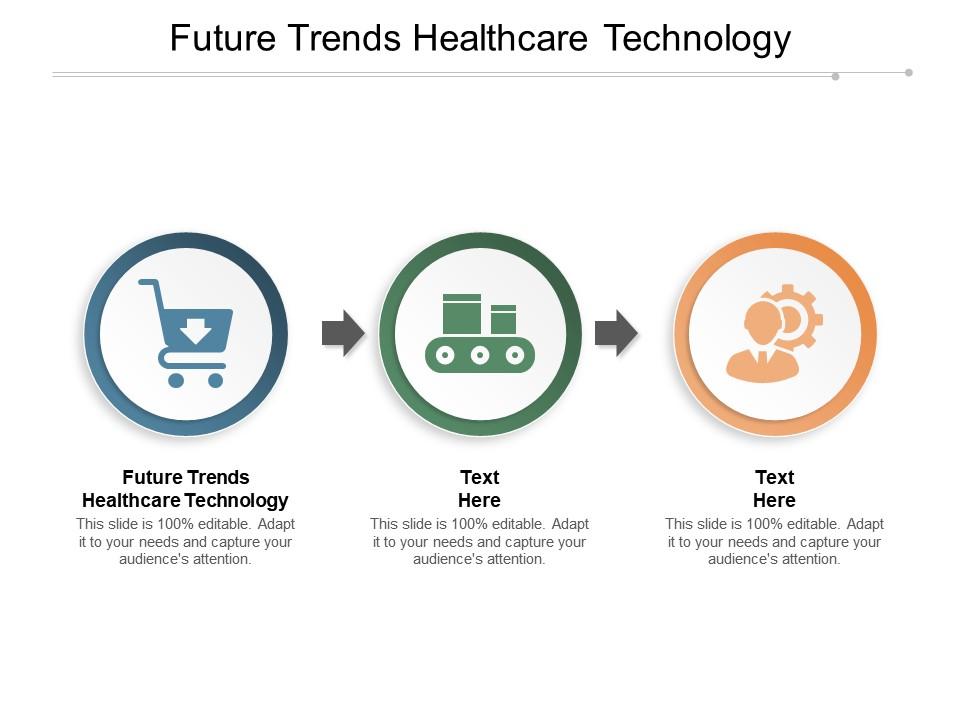
The quality and effectiveness of healthcare will continue to improve due to the development of cutting-edge technologies such as artificial Intelligence, machine learning, extended reality, and other advanced technologies.
Time and cost are essential when it comes to updating your healthcare company. It is important to hire dedicated software developer who acknowledges your requirements and aims.
EHR interoperability and consumer-centric healthcare are just a few of the 2022 technology trends in healthcare that show market leaders prefer efficiency. In the coming years, workflow optimization and interoperability are going to be more important than ever.
Conclusion
Digital transformation is being driven by the adoption of the latest trends in healthcare technology for creating software solutions. These top technology trends in healthcare will have a notable impact on how healthcare is brought to and the outcomes for patients.
Healthcare businesses should also be aware of the challenges and issues associated with implementing these trends. These include regulatory compliance, data privacy, and security, as well as a lack of interaction.
The first step in ensuring a seamless digital transformation for healthcare is to partner with the right mobile app development company. This will help you in developing a robust app and help you reach greater heights.
Frequently Asked Questions
Q1. Why is it Important to Keep up With the Latest Technology Trends in Healthcare for Digital Transportation?
It is important to stay on top of healthcare digital transformation trends as it allows healthcare organizations better care for patients. Healthcare organizations can use digital transformation to improve patient outcomes, decrease costs, and increase their efficiency.
Q2. How to Develop A Healthcare App?
Developing a healthcare app can be challenging; however, these essential steps will help develop a healthcare app.
- Define the purpose
- Choose a platform
- Ensure Compliance with Healthcare Regulations
- Focus on User Experience
- test and Iterate
- Market and Promote
Q3. What is the Cost of Custom Software Development in Healthcare?
The cost of custom software development in healthcare depends on various factors, including complexity, functionalities, tech stack, etc. however, the cost estimation for healthcare software will be around $25000-$50000.

